

Well-Preserved Maya Canoe Found in Mexico May Be 1,000 Years Old. Dr. Huson Predicts Comet will Destroy the Earth in 1911 – Sheridan Media. The End Is Coming Says Dr.
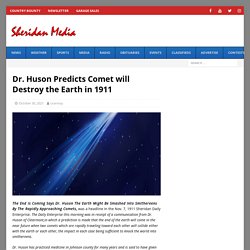
Huson The Earth Might Be Smashed Into Smithereens By The Rapidly Approaching Comets, was a headline in the Nov. 7, 1911 Sheridan Daily Enterprise. The Daily Enterprise this morning was in receipt of a communication from Dr. Huson of Clearmont,in which a prediction is made that the end of the earth will come in the near future when two comets which are rapidly traveling toward each other will collide either with the earth or each other, the impact in each case being sufficient to knock the world into smithereens. Dr. Huson has practiced medicine in Johnson county for many years and is said to have given much thought to the subject of astronomy. Dr. Hubble Captures Brilliant Cosmic Fireworks. Galaxy NGC 6984, an elegant spiral galaxy in the constellation Indus roughly 200 million light-years away from Earth, captured by the Hubble Space Telescope.
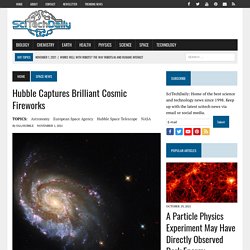
Credit: ESA/Hubble & NASA, D. Milisavljevic This NASA/ESA Hubble Space Telescope Picture of the Week features the galaxy NGC 6984, an elegant spiral galaxy in the constellation Indus roughly 200 million light-years away from Earth. The galaxy is a familiar sight for Hubble, having already been captured in 2013. The sweeping spiral arms are threaded through with a delicate tracery of dark lanes of gas and dust, and studded with bright stars and luminous star-forming regions. Compositions of exoplanets and their stars have a surprising relationship, study reveals. Asteroid flew strikingly close to the Earth without astronomers seeing. An asteroid the size of a refrigerator came within 3000 kilometres of the Earth without scientists knowing.

Asteroid 2021 UA1 is the third-closest asteroid that has ever approached our planet, passing over Antarctica on Sunday at a higher altitude than the International Space Station, but lower than the communication satellites that orbit the Earth. New Idea: Use the Starship HLS to Create a Lunar Base! Between the multiple space agencies planning to conduct crewed missions to the lunar surface, the many commercial entities who’ve contracted them to assist them, and proposals for lunar bases, the message of the modern space age is clear: We’re going back to the Moon.

And this time, we intend to stay! Just like the efforts of the Apollo Era, this entails several challenges, ones that require “the best of our energies and skills.” These challenges are leading to all sorts of innovative solutions, which recognize the need to leverage lunar resources to provide protection against the environment and see to peoples’ needs. NASA’s Juno Probe Offers First 3D View of Jupiter's Atmosphere, Inner Workings of Great Red Spot. Jupiter’s banded appearance is created by the cloud-forming “weather layer.”

This composite image shows views of Jupiter in (left to right) infrared and visible light taken by the Gemini North telescope and NASA’s Hubble Space Telescope, respectively. Credit: International Gemini Observatory/NOIRLab/NSF/AURA/NASA/ESA, M.H. Wong and I. de Pater (UC Berkeley) et al. Something Really Wants Our Attention: One Cosmic Object Emitted 1,652 Fast Radio Bursts in 47 Days. FAST catches a real pulse from FRB 121102.

Credit: NAOC The energetic phenomena known as Fast Radio Bursts (FRBs) are one of the greatest cosmic mysteries today. Signs of an extreme planet found in another galaxy. About 28 million years ago in the distant Whirlpool Galaxy, a blue supergiant star was having a downright miserable time.
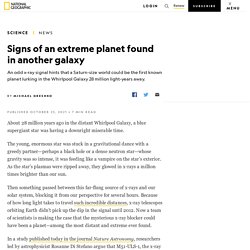
The young, enormous star was stuck in a gravitational dance with a greedy partner—perhaps a black hole or a dense neutron star—whose gravity was so intense, it was feeding like a vampire on the star’s exterior. As the star’s plasmas were ripped away, they glowed in x-rays a million times brighter than our sun. Then something passed between this far-flung source of x-rays and our solar system, blocking it from our perspective for several hours. Because of how long light takes to travel such incredible distances, x-ray telescopes orbiting Earth didn’t pick up the dip in the signal until 2012. MIT Scientists Zero In on the Origins of Earth’s “Single Most Important Evolutionary Innovation”
A new study shows oxygenic photosynthesis likely evolved between 3.4 and 2.9 billion years ago.

Some time in Earth’s early history, the planet took a turn toward habitability when a group of enterprising microbes known as cyanobacteria evolved oxygenic photosynthesis — the ability to turn light and water into energy, releasing oxygen in the process. This evolutionary moment made it possible for oxygen to eventually accumulate in the atmosphere and oceans, setting off a domino effect of diversification and shaping the uniquely habitable planet we know today. Now, MIT scientists have a precise estimate for when cyanobacteria, and oxygenic photosynthesis, first originated.
Their results were published on September 29, 2021, in the Proceedings of the Royal Society B. New Evidence Confirms Atom-Sized Primordial Blackholes. Since the earliest times, human beings have wanted to explain the most unpredictable and disturbing phenomena in the universe.
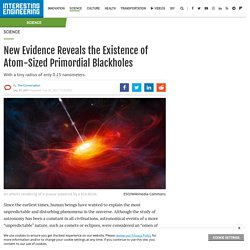
Although the study of astronomy has been a constant in all civilisations, astronomical events of a more “unpredictable” nature, such as comets or eclipses, were considered an “omen of misfortune” and/or “actions of the gods”. Using a Galactic-Scale Detector to narrow in on Gravitational Waves. Like their electromagnetic counterparts, gravitational waves also come in a spectrum - with different mass objects generating different frequencies.
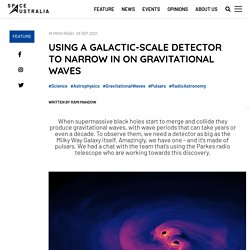
The confirmed gravitational wave detections made thus far are at higher frequencies and are generated by the stellar-mass objects. To catch these signals, giant L-shaped interferometers are used, utilising lasers bouncing back and forth along their kilometre-scale arms, to produce an interference pattern - which when disturbed, might be indicative of a passing gravitational wave. Possible Super-Earth in the Habitable Zone at Alpha Centauri. Astronomers using a new technique may have not only found a super-Earth at a neighbouring star, but they may also have directly imaged it. And it could be nice and cozy in the habitable zone around Alpha Centauri. It’s much easier to see giant planets than Earth-size planets. No matter which detection method is being used, larger planets are simply a larger needle in the cosmic haystack.
But overall, astronomers are very interested in planets that are similar to Earth. Engadget is now a part of Verizon Media. Engadget is part of Verizon Media. We and our partners will store and/or access information on your device through the use of cookies and similar technologies, to display personalised ads and content, for ad and content measurement, audience insights and product development. Your personal data that may be used Information about your device and internet connection, including your IP address Browsing and search activity while using Verizon Media websites and apps Precise location.
Ursid Meteor Shower Peaks Soon - Videos from The Weather Channel. The best meteor shower of 2020 is about to light up our atmosphere. The best meteor shower of 2020 is about to light up our atmosphere. Engadget is now a part of Verizon Media. Cosmic 'Jekyll and Hyde' discovered as NASA spots rare double star system. Dream Job? NASA Is Hiring New Astronauts For Moon Mission. For anyone reminiscing about their childhood, you may remember being asked at school “what do you want to be when you're older?” Doctor, sports player...astronaut! All very common answers, and although few of us follow through with our childhood dreams and career ambitions, now may be your chance to become employed in one the world’s rarest positions.
Choice page. Princely tomb of Iron Age mystery man discovered in Italy. And there’s a chariot inside.
The Future Is Now (And It Ain't Pretty): What Sci-Fi Forecast For The 2020s. November 20, 2019, was something of a red-letter day for sci-fi fans as it marked the date on which the futuristic setting for the cult film Blade Runner became a reality. NASA Wants to Launch a New Telescope to Search for a Second Earth. With environmental catastrophes befalling Earth and an increasing population, there’s an argument that for humanity to survive, we’ll need to find a new planet. -8. Aerial radar turns up a Viking ship in a farmer’s field.
Earth's magnetic song recorded for the first time during a solar storm. Entanglement, Space-Time Wormholes, and the Brain - John Hagelin. NASA report finds Boeing seat prices are 60% higher than SpaceX. On Thursday, NASA's inspector general released a report on the space agency's commercial crew program, which seeks to pay Boeing and SpaceX to develop vehicles to transport astronauts to the International Space Station. Although the report cites the usual technical issues that the companies are having with the development of their respective Starliner and Dragon spacecraft, far more illuminating is its discussion of costs. Why dark matter's no-show could mean a big bang rethink. Scientists Find a Spot Where No Life Can Survive. That's Bad News for Alien Hunters. -crew-dragon-abort-static-fire-test. CAPE CANAVERAL, Fla. — SpaceX's Crew Dragon astronaut taxi successfully fired its launch-escape engines on the ground today (Nov. 13) at the company's facilities at Cape Canaveral Air Force Station, keeping the vehicle on target for a crucial flight test in the coming weeks.
The brief "static fire," which occurred at approximately 3:08 p.m. Hayabusa-2: Japan spacecraft leaves asteroid to head home. Image copyright Jaxa/AFP. Mysteries behind interstellar buckyballs finally answered. Why dark matter's no-show could mean a big bang rethink. An incredible video shows what we would see if the planets replaced the moon. But that would turn Earth into a volcanic hellscape. A Supermassive Black Hole Yeeted This Star at 3.7 Million MPH.